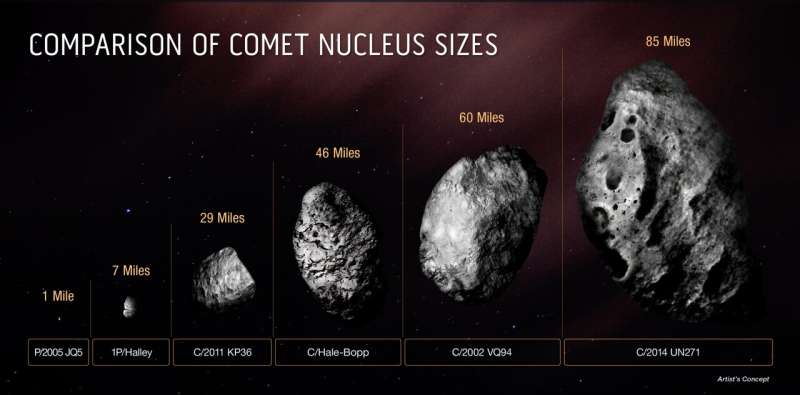Astronomers using NASA's Hubble Telescope have confirmed the existence the largest comet ever discovered, and it will pass by our sun in the next decade.
Comets are different from asteroids in that asteroids are rocky objects, while as a comet is a ball of ice and dust.
Comets are also known for the "tail" they leave behind and the glowing head, or nucleus, that appears as it approaches the sun.
Now astronomers have determined the size of "the largest icy comet nucleus ever seen."
Comet C/2014 UN271, also known as Comet Bernardinelli-Bernstein, is about 80 miles wide, larger than Rhode Island.
Its nucleus is estimated to weigh 500 trillion tons, about 100,000 times greater than most comets.
Also, the comet is traveling at 22,000 mph and headed closer to Earth.
It won't be of any concern when it makes its closest approach in 2031, because it will be around 1 billion miles away from the sun, slightly farther than the distance between Earth and Saturn.
Source
Comets are different from asteroids in that asteroids are rocky objects, while as a comet is a ball of ice and dust.
Comets are also known for the "tail" they leave behind and the glowing head, or nucleus, that appears as it approaches the sun.
Now astronomers have determined the size of "the largest icy comet nucleus ever seen."
Comet C/2014 UN271, also known as Comet Bernardinelli-Bernstein, is about 80 miles wide, larger than Rhode Island.
Its nucleus is estimated to weigh 500 trillion tons, about 100,000 times greater than most comets.
Also, the comet is traveling at 22,000 mph and headed closer to Earth.
It won't be of any concern when it makes its closest approach in 2031, because it will be around 1 billion miles away from the sun, slightly farther than the distance between Earth and Saturn.
Source






















